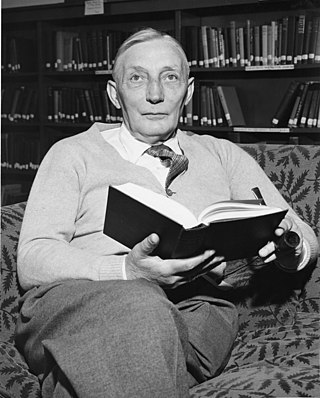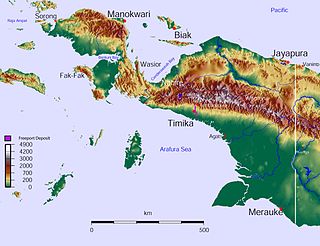Petrus Kafiar (died 1926) was an evangelist active on Irian Jaya.
Contents
Petrus Kafiar | |
|---|---|
 | |
| Born | 1864 or 1873 |
| Died | 1926 Supiori Island |
| Occupation(s) | Preacher Christian missionary |
Petrus Kafiar (died 1926) was an evangelist active on Irian Jaya.
Petrus Kafiar | |
|---|---|
 | |
| Born | 1864 or 1873 |
| Died | 1926 Supiori Island |
| Occupation(s) | Preacher Christian missionary |
The son of a headman, Kafiar was a native of Supiori Island; [1] his date of birth has been given variously as 1864 [2] and c. 1873. [1] When he was seven years old he was kidnapped during a raid, and was sold for fifty florins to a Moluccan carpenter, a Christian, and his wife; [3] an Indonesian missionary couple at Mansinam paid to ensure his liberation. He received his baptism in 1887. [1]
In 1892 he and another Papuan, Timotheus Awendu, were sent under the auspices of the Mansinam mission to attend the Depok Seminary to study for missionary work. [4] Kafiar became a teacher-preacher, serving in various locations before returning in 1908 to the village of his birth. He went on to become a pioneer of missionary work in Biak. [1] He was fluent in both Dutch and Malay, which added to his appeal among the Biaks, [5] who came to be seen as the most successful of those groups Christianized under the Dutch. [6]

A missionary is a member of a religious group who is sent into an area in order to promote its faith or provide services to people, such as education, literacy, social justice, health care, and economic development.

Congregationalism is a Reformed (Calvinist) tradition of Protestant Christianity in which churches practice congregational government. Each congregation independently and autonomously runs its own affairs. These principles are enshrined in the Cambridge Platform (1648) and the Savoy Declaration (1658), Congregationalist confessions of faith. The Congregationalist Churches are a continuity of the theological tradition upheld by the Puritans. Their genesis was through the work of Congregationalist divines Robert Browne, Henry Barrowe, and John Greenwood.

Biak is the main island of Biak Archipelago located in Cenderawasih Bay near the northern coast of Papua, an Indonesian province, and is just northwest of New Guinea. Biak has many atolls, reefs, and corals.

Samuel Crowther was a Yoruba linguist, clergyman, and the first African Anglican bishop of West Africa. Born in Osogun, he and his family were captured by Fulani slave raiders when he was about twelve years old. This took place during the Yoruba civil wars, notably the Owu wars of 1821–1829, where his village Osogun was ransacked. Ajayi was later on resold to Portuguese slave dealers, where he was put on board to be transported to the New World through the Atlantic.

The Catholic Church in Indonesia is part of the worldwide Catholic Church, under the spiritual leadership of the pope in Rome. Catholicism is one of the six approved religions in Indonesia, the others being Islam, Protestantism, Hinduism, Buddhism, and Confucianism. According to official figures, Catholics made up 3.12 percent of the population in 2018. The number of Catholics is, therefore, more than 8.3 million. Indonesia is primarily Muslim, but Catholicism is the dominant faith in certain areas of the country.

Several different religions are practised in Indonesia. Indonesia is officially a presidential republic and a unitary state without an established state religion. The first principle of Indonesia's philosophical foundation, Pancasila, requires its citizens to state the belief in "the one and almighty God". Although, as explained by the Constitutional Court, this first sila of Pancasila is an explicit recognition of divine substances and meant as a principle on how to live together in a religiously diverse society. Blasphemy is a punishable offence and the Indonesian government has a discriminatory attitude towards its numerous tribal religions, atheist and agnostic citizens. In addition, the Aceh province officially applies Sharia law and is notorious for its discriminatory practices towards religious and sexual minorities.
Henry Martyn Scudder was a missionary under the American Board of Commissioners for Foreign Missions and Board of Foreign Missions of the Reformed Church in America to Japan and South India—to the American Madura Mission and American Madras Mission. He also established the American Arcot Mission, North Arcot of South India—then under Madras Presidency.

Christianity is Indonesia's second-largest religion, after Islam. Indonesia also has the second-largest Christian population in Southeast Asia after the Philippines, the largest Protestant population in Southeast Asia, and the third-largest Christian population in Asia after the Philippines and China. Indonesia also has the second-largest Christian population in the Muslim world, after Nigeria, followed by Egypt. Indonesia's 29.4 million Christians constituted 10.47% of the country's population in 2023, with 7.41% Protestant and 3.06% Catholic. Some provinces in Indonesia are majority Christian. In Indonesia, the word Kristen refers to Protestantism, while Catholicism is referred to as Katolik. In the 21st century the rate of growth and spread of Christianity has increased, especially among the Chinese minority.

Johannes Leimena, more colloquially referred to as Om Jo, was an Indonesian politician, physician, and national hero. He was one of the longest-serving government ministers in Indonesia, and was the longest-serving under President Sukarno. He filled the roles of Deputy Prime Minister and Minister of Health. An Ambonese Christian, he served in the People's Representative Council and the Constitutional Assembly during the 1950s, and was the chairman of the Indonesian Christian Party from 1951 until 1960.

Hendrik Kraemer was a lay missiologist and figure in the ecumenical movement from Dutch Reformed Church in the Netherlands. He encouraged the Dutch to allow the spread missionary activities outside of the Dutch East India Company-restricted area in eastern Indonesia to the rest of the archipelago.
Jager Afrikaner was the third Captain of the Orlam people in South West Africa, succeeding his father Klaas Afrikaner at around 1800. Before converting to Christianity through the missionary efforts of Robert Moffat, Afrikaner and his followers were considered notorious bandits. He was one of the founders of Namibia's first systematic settlement in an engineering sense, ǁKhauxaǃnas. After his death in 1823 his son Jonker Afrikaner succeeded him as Captain of the Afrikaner Orlams.

Susanna "Susie" Carson Rijnhart, was a Canadian medical doctor, Protestant missionary, and Tibetan explorer. She was the second Western woman known to have visited Tibet, after Annie Royle Taylor.

Toraja Church is a Protestant Christian denomination in Tana Toraja, Indonesia, of which the majority of the Torajan people are members. This church is a member of the Communion of Churches in Indonesia since 1950. On 1912-1913 the Gereformerde Missionary Bond-Holland of the Dutch Reformed Church begun working in this part of the country. On 7 November 1913, Reverend A.A. van de Loosdrecht became the first missionary who came to Rantepao. This time became the starting point when the Gospel was grown in the Torajanese's heart. But, Reverend van de Loosdrecht was killed in that place. In 1938 there were 14,000 Christians from 300,000 inhabitants there. Formally, Toraja Church was established on 25 March 1947 in Rantepao. In 1995 the church had 300,000 adherents. In 2012 the church had 400,000 members and 959 congregations. This church is the largest in South Sulawesi, with approximately 80% of the Christian population belong to it. It is a member of the World Communion of Reformed Churches.

Sierk Coolsma was a Dutch Protestant missionary who wrote extensively on the Sundanese language. Born in the Netherlands, he became a missionary in his early twenties and arrived in the Dutch East Indies in 1865. First tasked to Cianjur, he studied Sundanese in more detail than his contemporaries, gaining an appreciation for the language. Further missionary activities in Bogor, begun in 1869, were a failure, and in 1873 he was tasked with translating the New Testament into Sundanese. Although the Sundanese people highly valued poetry, he did the translation in prose hoping that it would help readers entertain new ideas.

The West New Guinea dispute (1950–1962), also known as the West Irian dispute, was a diplomatic and political conflict between the Netherlands and Indonesia over the territory of Dutch New Guinea. While the Netherlands had ceded sovereignty over most of the Dutch East Indies to Indonesia on 27 December 1949 following an independence struggle, it retained control over its colony on the western half of New Guinea. The Indonesian government claimed this territory as well, on the basis that it had belonged to the Dutch East Indies and that the new Republic of Indonesia was the legitimate successor to the former Dutch colony.

Albert Christian Kruyt was a Dutch Calvinist missionary, ethnographer and theologian who pioneered Christianity in Poso, Indonesia.

The Denpasar Conference was held from 7–24 December 1946 at the Hotel Bali, Denpasar and resulted in the establishment of the State of East Indonesia, part of the United States of Indonesia.
Kepi is a town in Mappi Regency, South Papua, Indonesia. Following the formation of Mappi Regency in 2002, the town became its administrative seat.

Tapanoeli Residency was an administrative subdivision of the Dutch East Indies with its capital in Sibolga. It was located in northern Sumatra and existed in various forms from 1844 until the end of Dutch rule in 1942. The area it encompassed at various times corresponds to most of the western coast of the current day Indonesian province of North Sumatra and parts of Aceh, including much of the traditional heartland of Batak people. Lake Toba, a historically important crater lake, was also within the borders of the Residency.
![]() Media related to Petrus Kafiar at Wikimedia Commons
Media related to Petrus Kafiar at Wikimedia Commons